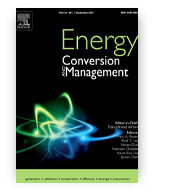Solar-hydro cable pooling – Utilizing the untapped potential of existing grid infrastructure
Jakub Jurasz; Paweł Tomczyk; Bogdan Bochenek; Alban Kuriqi; Egidijus Kasiulis; Diyi Chen; Bo Ming
Energy Conversion and Management
Ministerial score = 200.0
Journal Impact Factor (2023) = 10.4 (Q1)
 Over the years, the coupling of various variable renewable energy sources has emerged as a convenient way to partially or fully overcome their highly intermittent nature and low-capacity factors. In literature as well as in practical implementations, the coupling of solar and wind power systems is gaining special attention thanks to their advantageous complementarity in time. However, an area of yet not well-documented potential is the coupling of solar PV plants with non-dispatchable run-of-river hydropower plants. In this study, Poland, which still has significant untapped hydropower potential, is used as a case study. The objective of the work is to quantify the coupling potential with special attention paid to the unavoidable curtailment of solar generation due to the limited grid connection capacity. A simulation model was developed that uses input runoff, irradiation, and temperature hourly data covering the period 01.01.2008–31.12.2022 for 236 selected sites in Poland. Hydrological data were obtained from field measurements, while the remaining meteorological parameters were downloaded from the ERA5 reanalysis database. Hydropower generation was simulated assuming a constant head and a Kaplan turbine operating at different efficiencies depending on the flow rate through the turbine. The available flow was calculated considering environmental flow (e-flows) constraints. The design flow was determined based on the average multi-year flow in the considered river. The complementarity in time of these two renewable energy sources in each location was assessed by considering the grid connection capacity and resulting curtailment in case of too high simultaneous generation from both sources. The analysis showed that the average PV curtailment is about 10.7 % (or 13.2 % when it is solar PV capacity weighted) when the ratio of solar to hydro is equal. Still, it can be as high as 19.7 % in individual cases. To ensure that PV curtailment is no more than arbitrarily (in that case) selected threshold of 5 %, the solar-PV capacity should be between 58 % − 120 % of the designed hydropower plant capacity. The curtailment threshold can be further investigated as an expansion of a techno-economic analysis that fell out of the scope of this work. The additional analysis conducted by means of daily flow data showed a significant underestimation of solar curtailment in individual cases (i.e., up to 7 pp.) and, on average, lower by 0.24 pp. could be expected. Due to interannual flow variations, although the expected mean solar curtailment can be no more than 5 %, there are individual years when it is as low as 2 % and as high as 12 % of this year’s solar generation. The lessons learned from this study shed light on the potential maximization of local power generation through coupling with PV systems and the simultaneous reduction of environmental impacts by releasing higher quantities of e-flows offset by the integration of PV systems.
Over the years, the coupling of various variable renewable energy sources has emerged as a convenient way to partially or fully overcome their highly intermittent nature and low-capacity factors. In literature as well as in practical implementations, the coupling of solar and wind power systems is gaining special attention thanks to their advantageous complementarity in time. However, an area of yet not well-documented potential is the coupling of solar PV plants with non-dispatchable run-of-river hydropower plants. In this study, Poland, which still has significant untapped hydropower potential, is used as a case study. The objective of the work is to quantify the coupling potential with special attention paid to the unavoidable curtailment of solar generation due to the limited grid connection capacity. A simulation model was developed that uses input runoff, irradiation, and temperature hourly data covering the period 01.01.2008–31.12.2022 for 236 selected sites in Poland. Hydrological data were obtained from field measurements, while the remaining meteorological parameters were downloaded from the ERA5 reanalysis database. Hydropower generation was simulated assuming a constant head and a Kaplan turbine operating at different efficiencies depending on the flow rate through the turbine. The available flow was calculated considering environmental flow (e-flows) constraints. The design flow was determined based on the average multi-year flow in the considered river. The complementarity in time of these two renewable energy sources in each location was assessed by considering the grid connection capacity and resulting curtailment in case of too high simultaneous generation from both sources. The analysis showed that the average PV curtailment is about 10.7 % (or 13.2 % when it is solar PV capacity weighted) when the ratio of solar to hydro is equal. Still, it can be as high as 19.7 % in individual cases. To ensure that PV curtailment is no more than arbitrarily (in that case) selected threshold of 5 %, the solar-PV capacity should be between 58 % − 120 % of the designed hydropower plant capacity. The curtailment threshold can be further investigated as an expansion of a techno-economic analysis that fell out of the scope of this work. The additional analysis conducted by means of daily flow data showed a significant underestimation of solar curtailment in individual cases (i.e., up to 7 pp.) and, on average, lower by 0.24 pp. could be expected. Due to interannual flow variations, although the expected mean solar curtailment can be no more than 5 %, there are individual years when it is as low as 2 % and as high as 12 % of this year’s solar generation. The lessons learned from this study shed light on the potential maximization of local power generation through coupling with PV systems and the simultaneous reduction of environmental impacts by releasing higher quantities of e-flows offset by the integration of PV systems.
DOI:10.1016/j.enconman.2024.118307









